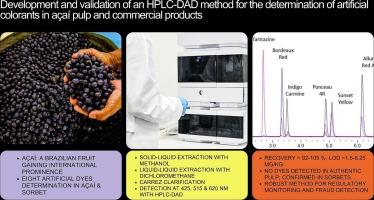开发和验证HPLC-DAD法测定açaí纸浆和商业产品中的人工着色剂
IF 8
1区 农林科学
Q1 FOOD SCIENCE & TECHNOLOGY
引用次数: 0
摘要
人工色素经常用于商业食品中,以增强视觉吸引力。然而,它们在açaí果肉(一种以其健康益处而闻名的巴西流行水果)中的使用是巴西法规禁止的,这使得未经授权的存在成为食品欺诈的潜在迹象。本研究建立了HPLC-DAD同时测定açaí和juara纸浆和açaí-based冰沙中8种人工染料(酒黄、波尔多红、Ponceau 4R、Sunset Yellow FCF、Allura Red AC、Erythrosine、Indigo Carmine和Brilliant Blue FCF)的方法,并对其进行了优化和验证。采用单质心混合设计优化提取工艺,采用二氯甲烷液液萃取去除脂质,采用Carrez I和II试剂沉淀蛋白质。优化色谱条件以确保在14 min梯度下的基线分离。结果表明,该方法具有合适的选择性、线性(大多数分析物的R2和gt; 0.98)、低检出限(1.5-6.25 mg.kg−1)和可接受的回收率(92-105%)。该方法应用于一系列商业样品,以识别合规和潜在掺假的产品。本研究为açaí-based产品的监管监测和真实性评估提供了强有力的工具。本文章由计算机程序翻译,如有差异,请以英文原文为准。

Development and validation of an HPLC-DAD method for the determination of artificial colorants in açaí pulp and commercial products
Artificial colorants are frequently used in commercial food products to enhance visual appeal. However, their use in açaí pulp—a popular Brazilian fruit known for its health benefits—is prohibited by Brazilian regulations, making their unauthorized presence a potential indicator of food fraud. This study reports the development, optimization, and validation of an HPLC-DAD method for the simultaneous determination of eight artificial dyes (Tartrazine, Bordeaux Red, Ponceau 4R, Sunset Yellow FCF, Allura Red AC, Erythrosine, Indigo Carmine, and Brilliant Blue FCF) in açaí and juçara pulps and açaí-based sorbets. Extraction was optimized using a simplex-centroid mixture design and included liquid–liquid extraction with dichloromethane for lipid removal and protein precipitation using Carrez I and II reagents. Chromatographic conditions were optimized to ensure baseline separation under a 14 min gradient. The method was validated according to regulatory guidelines, showing suitable selectivity, linearity (R2 > 0.98 for most analytes), low detection limits (1.5–6.25 mg.kg−1), and acceptable recovery (92–105%). The method was applied to a range of commercial samples to identify both compliant and potentially adulterated products. This study provides a robust tool for regulatory monitoring and authenticity assessment of açaí-based products.
求助全文
通过发布文献求助,成功后即可免费获取论文全文。
去求助
来源期刊

Food Research International
工程技术-食品科技
CiteScore
12.50
自引率
7.40%
发文量
1183
审稿时长
79 days
期刊介绍:
Food Research International serves as a rapid dissemination platform for significant and impactful research in food science, technology, engineering, and nutrition. The journal focuses on publishing novel, high-quality, and high-impact review papers, original research papers, and letters to the editors across various disciplines in the science and technology of food. Additionally, it follows a policy of publishing special issues on topical and emergent subjects in food research or related areas. Selected, peer-reviewed papers from scientific meetings, workshops, and conferences on the science, technology, and engineering of foods are also featured in special issues.
 求助内容:
求助内容: 应助结果提醒方式:
应助结果提醒方式:


